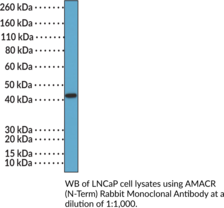Cayman
Showing 9301–9450 of 45550 results
-
AM679 is a potent synthetic cannabinoid (CB) with Ki values of 13.5 and 49.5 nM for the CB1 and CB2 receptors, respectively.{18696} The physiological and toxicological properties of this compound are not known. This product is intended for research and forensic applications.
Brand:CaymanSKU:11504 - 5 mgAvailable on backorder
AM694 is a potent synthetic cannabinoid (CB) with Ki values of 0.08 and 1.44 nM for the CB1 and CB2 receptors, respectively.{18696} The physiological actions and metabolism of AM694 have not been characterized.
Brand:CaymanSKU:-AM694 is a potent synthetic cannabinoid (CB) with Ki values of 0.08 and 1.44 nM for the CB1 and CB2 receptors, respectively.{18696} AM694 3-iodo isomer is an analog of AM694 which contains a 3-iodophenyl group linked by methanone to the indole base. Its affinity for CB receptors has not been determined. This compound is intended for forensic applications.
Brand:CaymanSKU:10870 - 1 mgAvailable on backorder
AM694 is a potent synthetic cannabinoid (CB) with Ki values of 0.08 and 1.44 nM for the CB1 and CB2 receptors, respectively.{18696} AM694 3-iodo isomer is an analog of AM694 which contains a 3-iodophenyl group linked by methanone to the indole base. Its affinity for CB receptors has not been determined. This compound is intended for forensic applications.
Brand:CaymanSKU:10870 - 10 mgAvailable on backorder
AM694 is a potent synthetic cannabinoid (CB) with Ki values of 0.08 and 1.44 nM for the CB1 and CB2 receptors, respectively.{18696} AM694 3-iodo isomer is an analog of AM694 which contains a 3-iodophenyl group linked by methanone to the indole base. Its affinity for CB receptors has not been determined. This compound is intended for forensic applications.
Brand:CaymanSKU:10870 - 5 mgAvailable on backorder
AM694 is a potent synthetic cannabinoid (CB) with Ki values of 0.08 and 1.44 nM for the CB1 and CB2 receptors, respectively.{18696} AM694 4-iodo isomer is an analog of AM694 which contains a 4-iodophenyl group linked by methanone to the indole base. Its affinity for CB1 and CB2 receptors has not been determined. The pharmacological, physiological, and toxicological properties of AM694 4-iodo isomer are not known.
Brand:CaymanSKU:10869 - 1 mgAvailable on backorder
AM694 is a potent synthetic cannabinoid (CB) with Ki values of 0.08 and 1.44 nM for the CB1 and CB2 receptors, respectively.{18696} AM694 4-iodo isomer is an analog of AM694 which contains a 4-iodophenyl group linked by methanone to the indole base. Its affinity for CB1 and CB2 receptors has not been determined. The pharmacological, physiological, and toxicological properties of AM694 4-iodo isomer are not known.
Brand:CaymanSKU:10869 - 10 mgAvailable on backorder
AM694 is a potent synthetic cannabinoid (CB) with Ki values of 0.08 and 1.44 nM for the CB1 and CB2 receptors, respectively.{18696} AM694 4-iodo isomer is an analog of AM694 which contains a 4-iodophenyl group linked by methanone to the indole base. Its affinity for CB1 and CB2 receptors has not been determined. The pharmacological, physiological, and toxicological properties of AM694 4-iodo isomer are not known.
Brand:CaymanSKU:10869 - 5 mgAvailable on backorder
AM694 (Item No. 10567) is a potent synthetic cannabinoid (CB) with Ki values of 0.08 and 1.44 nM for the central CB1 and peripheral CB2 receptors, respectively.{18696} AM694 N-(5-hydroxypentyl) metabolite is an expected urinary metabolite of AM694, based on the known metabolism of similar compounds.{19353} Its biological actions are unknown. This product is intended for forensic and research applications.
Brand:CaymanSKU:-AM694 (Item No. 10567) is a potent synthetic cannabinoid (CB) with Ki values of 0.08 and 1.44 nM for the central CB1 and peripheral CB2 receptors, respectively.{18696} AM694 N-(5-hydroxypentyl) metabolite is an expected urinary metabolite of AM694, based on the known metabolism of similar compounds.{19353} Its biological actions are unknown. This product is intended for forensic and research applications.
Brand:CaymanSKU:-AM694 (Item No. 10567) is a potent synthetic cannabinoid (CB) with Ki values of 0.08 and 1.44 nM for the central CB1 and peripheral CB2 receptors, respectively.{18696} AM694 N-(5-hydroxypentyl) metabolite is an expected urinary metabolite of AM694, based on the known metabolism of similar compounds.{19353} Its biological actions are unknown. This product is intended for forensic and research applications.
Brand:CaymanSKU:-AM694 (Item No. 10567) is a potent synthetic cannabinoid (CB) with Ki values of 0.08 and 1.44 nM for the central CB1 and peripheral CB2 receptors, respectively.{18696} AM694 N-pentanoic acid metabolite is a potential phase I metabolite of AM694, based on the known metabolism of similar compounds.{19353} The physiological and toxicological properties of this compound have not been evaluated. This product is intended for forensic and research applications.
Brand:CaymanSKU:-AM694 (Item No. 10567) is a potent synthetic cannabinoid (CB) with Ki values of 0.08 and 1.44 nM for the central CB1 and peripheral CB2 receptors, respectively.{18696} AM694 N-pentanoic acid metabolite is a potential phase I metabolite of AM694, based on the known metabolism of similar compounds.{19353} The physiological and toxicological properties of this compound have not been evaluated. This product is intended for forensic and research applications.
Brand:CaymanSKU:-AM694 (Item No. 10567) is a potent synthetic cannabinoid (CB) with Ki values of 0.08 and 1.44 nM for the central CB1 and peripheral CB2 receptors, respectively.{18696} AM694 N-pentanoic acid metabolite is a potential phase I metabolite of AM694, based on the known metabolism of similar compounds.{19353} The physiological and toxicological properties of this compound have not been evaluated. This product is intended for forensic and research applications.
Brand:CaymanSKU:-AM80 is a retinoic acid receptor agonist that is selective for RARα (Kd = 62 nM; AC50 = 1.46 nM) compared to RARβ (Kd = 280 nM; AC50 = 6.87 nM) and RARγ (Kd = 816 nM; AC50 = 148.7 nM).{24736} It demonstrates greater specific binding to RARα compared to retinoic acid (Item No. 11017), which exhibits little selectivity across RARα, β, or γ.{25644,24736} AM80 exhibits antiproliferative effects against acute promyelocytic leukemia cells, inducing human promyelocytic leukemia HL-60 cell differentiation with an ED50 value of 0.79 nM.{23266,25644} It has also been shown to suppress the growth of other myeloid and lymphoid malignant cells.{25644}
Brand:CaymanSKU:71770 - 10 mgAvailable on backorder
AM80 is a retinoic acid receptor agonist that is selective for RARα (Kd = 62 nM; AC50 = 1.46 nM) compared to RARβ (Kd = 280 nM; AC50 = 6.87 nM) and RARγ (Kd = 816 nM; AC50 = 148.7 nM).{24736} It demonstrates greater specific binding to RARα compared to retinoic acid (Item No. 11017), which exhibits little selectivity across RARα, β, or γ.{25644,24736} AM80 exhibits antiproliferative effects against acute promyelocytic leukemia cells, inducing human promyelocytic leukemia HL-60 cell differentiation with an ED50 value of 0.79 nM.{23266,25644} It has also been shown to suppress the growth of other myeloid and lymphoid malignant cells.{25644}
Brand:CaymanSKU:71770 - 25 mgAvailable on backorder
AM80 is a retinoic acid receptor agonist that is selective for RARα (Kd = 62 nM; AC50 = 1.46 nM) compared to RARβ (Kd = 280 nM; AC50 = 6.87 nM) and RARγ (Kd = 816 nM; AC50 = 148.7 nM).{24736} It demonstrates greater specific binding to RARα compared to retinoic acid (Item No. 11017), which exhibits little selectivity across RARα, β, or γ.{25644,24736} AM80 exhibits antiproliferative effects against acute promyelocytic leukemia cells, inducing human promyelocytic leukemia HL-60 cell differentiation with an ED50 value of 0.79 nM.{23266,25644} It has also been shown to suppress the growth of other myeloid and lymphoid malignant cells.{25644}
Brand:CaymanSKU:71770 - 5 mgAvailable on backorder
AM80 is a retinoic acid receptor agonist that is selective for RARα (Kd = 62 nM; AC50 = 1.46 nM) compared to RARβ (Kd = 280 nM; AC50 = 6.87 nM) and RARγ (Kd = 816 nM; AC50 = 148.7 nM).{24736} It demonstrates greater specific binding to RARα compared to retinoic acid (Item No. 11017), which exhibits little selectivity across RARα, β, or γ.{25644,24736} AM80 exhibits antiproliferative effects against acute promyelocytic leukemia cells, inducing human promyelocytic leukemia HL-60 cell differentiation with an ED50 value of 0.79 nM.{23266,25644} It has also been shown to suppress the growth of other myeloid and lymphoid malignant cells.{25644}
Brand:CaymanSKU:71770 - 50 mgAvailable on backorder
AM966 is an orally bioavailable, potent, and selective antagonist of the lysophosphatidic acid receptor 1 (LPA1) that has an IC50 value of 17 nM in a calcium assay using CHO cells transfected with the human LPA1 receptor.{36285} It is selective for LPA1 over the LPA2, LPA3, LPA4, and LPA5 receptors (IC50s = 1,700, 1,600, 7,700, and 8,600 nM for LPA2-5, respectively). In vitro, AM966 inhibits LPA-induced lung fibroblast cell chemotaxis (IC50 = 181 nM), increases barrier permeability, activates RhoA, and induces phosphorylation of myosin light chain and vascular endothelium cadherin (VE-cadherin).{36284,36283} At a dose of 30 mg/kg in mice, it reduces inflammation, tissue fibrosis, and vascular permeability following bleomycin-induced lung injury. AM966 also blocks amitriptyline-induced ERK1/2, CREB, and insulin growth factor-1 receptor (IGF-IR) phosphorylation in vitro.{36284}
Brand:CaymanSKU:22048 -Out of stock
AM966 is an orally bioavailable, potent, and selective antagonist of the lysophosphatidic acid receptor 1 (LPA1) that has an IC50 value of 17 nM in a calcium assay using CHO cells transfected with the human LPA1 receptor.{36285} It is selective for LPA1 over the LPA2, LPA3, LPA4, and LPA5 receptors (IC50s = 1,700, 1,600, 7,700, and 8,600 nM for LPA2-5, respectively). In vitro, AM966 inhibits LPA-induced lung fibroblast cell chemotaxis (IC50 = 181 nM), increases barrier permeability, activates RhoA, and induces phosphorylation of myosin light chain and vascular endothelium cadherin (VE-cadherin).{36284,36283} At a dose of 30 mg/kg in mice, it reduces inflammation, tissue fibrosis, and vascular permeability following bleomycin-induced lung injury. AM966 also blocks amitriptyline-induced ERK1/2, CREB, and insulin growth factor-1 receptor (IGF-IR) phosphorylation in vitro.{36284}
Brand:CaymanSKU:22048 -Out of stock
AM966 is an orally bioavailable, potent, and selective antagonist of the lysophosphatidic acid receptor 1 (LPA1) that has an IC50 value of 17 nM in a calcium assay using CHO cells transfected with the human LPA1 receptor.{36285} It is selective for LPA1 over the LPA2, LPA3, LPA4, and LPA5 receptors (IC50s = 1,700, 1,600, 7,700, and 8,600 nM for LPA2-5, respectively). In vitro, AM966 inhibits LPA-induced lung fibroblast cell chemotaxis (IC50 = 181 nM), increases barrier permeability, activates RhoA, and induces phosphorylation of myosin light chain and vascular endothelium cadherin (VE-cadherin).{36284,36283} At a dose of 30 mg/kg in mice, it reduces inflammation, tissue fibrosis, and vascular permeability following bleomycin-induced lung injury. AM966 also blocks amitriptyline-induced ERK1/2, CREB, and insulin growth factor-1 receptor (IGF-IR) phosphorylation in vitro.{36284}
Brand:CaymanSKU:22048 -Out of stock
AM966 is an orally bioavailable, potent, and selective antagonist of the lysophosphatidic acid receptor 1 (LPA1) that has an IC50 value of 17 nM in a calcium assay using CHO cells transfected with the human LPA1 receptor.{36285} It is selective for LPA1 over the LPA2, LPA3, LPA4, and LPA5 receptors (IC50s = 1,700, 1,600, 7,700, and 8,600 nM for LPA2-5, respectively). In vitro, AM966 inhibits LPA-induced lung fibroblast cell chemotaxis (IC50 = 181 nM), increases barrier permeability, activates RhoA, and induces phosphorylation of myosin light chain and vascular endothelium cadherin (VE-cadherin).{36284,36283} At a dose of 30 mg/kg in mice, it reduces inflammation, tissue fibrosis, and vascular permeability following bleomycin-induced lung injury. AM966 also blocks amitriptyline-induced ERK1/2, CREB, and insulin growth factor-1 receptor (IGF-IR) phosphorylation in vitro.{36284}
Brand:CaymanSKU:22048 -Out of stock
α-methylacyl-Coenzyme A (α-methylacyl-CoA) racemase (AMACR), is an enzyme involved in the metabolism of branched chain fatty acids and 2-arylpropanoic acids (2-APAs), such as ibuprofen (Item No. 70280).{60129} It is expressed in most human tissues and is localized to peroxisomes and mitochondria.{60129,60130} AMACR converts R-2-methyl fatty acids to S-2-methylacyl-CoA esters via an epimerization reaction prior to their degradation by β-oxidation.{60129} AMACR is overexpressed in localized and metastatic prostate cancer, as well as in a variety of other cancers.{60131} AMACR has been found selectively in patient-derived prostate cancer tumor tissue compared to non-cancer prostate tissue, and has been used as a biomarker of the disease.{60132} Mutations in AMACR resulting in reduced enzyme activity lead to the accumulation of R-2-methyl fatty acids and are associated with neurological and peroxisomal disorders.{60133} Cayman’s AMACR (N-Term) Rabbit Monoclonal Antibody can be used for immunohistochemistry (IHC) and Western blot (WB) applications.
Brand:CaymanSKU:32274 - 100 µlAvailable on backorder
Immunogen: Peptide from the N-terminal region of human p504s • Host: Rabbit • Species Reactivity: (+) Human • Cross Reactivity: (+) p504s • Applications: IHC, WB
Brand:CaymanSKU:32274- 100 µlAvailable on backorder
Immunogen: Peptide from the N-terminal region of human p504s • Host: Rabbit • Species Reactivity: (+) Human • Cross Reactivity: (+) p504s • Applications: IHC, WB
Brand:CaymanSKU:32274- 100 µlAmantadine is an NMDA receptor antagonist with IC50 values of 0.93, 0.82, and 0.47 μM at -70 mV for NR1-1a/NR2A, NR1-1a/NR2B, and NR1-1a/NR2D subunit-containing recombinant receptors, respectively, expressed in HEK293 cells.{42217} It blocks the influenza A M2 proton channel (IC50 = 16 μM for the recombinant channel expressed in Xenopus oocytes) and inhibits cytotoxicity induced by the influenza A strains H1N1 and H3N2 in MDCK cells (EC50s = 34 and 0.84 μM, respectively).{42218} It also improves the survival of mice infected with influenza A when administered 24 hours following viral challenge at a dose of 100 mg/kg per day.{42220} Amantadine (40 mg/kg) decreases dyskinesia induced by L-DOPA (Item No. 13248) in a 6-OHDA hemi-parkinsonian mouse model.{42219} Formulations containing amantadine have been used in the treatment of various strains of influenza A virus infection and in the treatment of parkinsonism and drug-induced extrapyramidal symptoms.
Brand:CaymanSKU:21364 -Out of stock
Amantadine is an NMDA receptor antagonist with IC50 values of 0.93, 0.82, and 0.47 μM at -70 mV for NR1-1a/NR2A, NR1-1a/NR2B, and NR1-1a/NR2D subunit-containing recombinant receptors, respectively, expressed in HEK293 cells.{42217} It blocks the influenza A M2 proton channel (IC50 = 16 μM for the recombinant channel expressed in Xenopus oocytes) and inhibits cytotoxicity induced by the influenza A strains H1N1 and H3N2 in MDCK cells (EC50s = 34 and 0.84 μM, respectively).{42218} It also improves the survival of mice infected with influenza A when administered 24 hours following viral challenge at a dose of 100 mg/kg per day.{42220} Amantadine (40 mg/kg) decreases dyskinesia induced by L-DOPA (Item No. 13248) in a 6-OHDA hemi-parkinsonian mouse model.{42219} Formulations containing amantadine have been used in the treatment of various strains of influenza A virus infection and in the treatment of parkinsonism and drug-induced extrapyramidal symptoms.
Brand:CaymanSKU:21364 -Out of stock
Amantadine is an NMDA receptor antagonist with IC50 values of 0.93, 0.82, and 0.47 μM at -70 mV for NR1-1a/NR2A, NR1-1a/NR2B, and NR1-1a/NR2D subunit-containing recombinant receptors, respectively, expressed in HEK293 cells.{42217} It blocks the influenza A M2 proton channel (IC50 = 16 μM for the recombinant channel expressed in Xenopus oocytes) and inhibits cytotoxicity induced by the influenza A strains H1N1 and H3N2 in MDCK cells (EC50s = 34 and 0.84 μM, respectively).{42218} It also improves the survival of mice infected with influenza A when administered 24 hours following viral challenge at a dose of 100 mg/kg per day.{42220} Amantadine (40 mg/kg) decreases dyskinesia induced by L-DOPA (Item No. 13248) in a 6-OHDA hemi-parkinsonian mouse model.{42219} Formulations containing amantadine have been used in the treatment of various strains of influenza A virus infection and in the treatment of parkinsonism and drug-induced extrapyramidal symptoms.
Brand:CaymanSKU:21364 -Out of stock
Amantadine is an NMDA receptor antagonist with IC50 values of 0.93, 0.82, and 0.47 μM at -70 mV for NR1-1a/NR2A, NR1-1a/NR2B, and NR1-1a/NR2D subunit-containing recombinant receptors, respectively, expressed in HEK293 cells.{42217} It blocks the influenza A M2 proton channel (IC50 = 16 μM for the recombinant channel expressed in Xenopus oocytes) and inhibits cytotoxicity induced by the influenza A strains H1N1 and H3N2 in MDCK cells (EC50s = 34 and 0.84 μM, respectively).{42218} It also improves the survival of mice infected with influenza A when administered 24 hours following viral challenge at a dose of 100 mg/kg per day.{42220} Amantadine (40 mg/kg) decreases dyskinesia induced by L-DOPA (Item No. 13248) in a 6-OHDA hemi-parkinsonian mouse model.{42219} Formulations containing amantadine have been used in the treatment of various strains of influenza A virus infection and in the treatment of parkinsonism and drug-induced extrapyramidal symptoms.
Brand:CaymanSKU:21364 -Out of stock
Amarogentin is a secoiridoid glycoside that has been found in Swertia and has diverse biological activities, including anticancer, antidiabetic, and anti-leishmanial properties.{43265,43266,43267} It inhibits the growth of SNU-16 human gastric cancer cells (IC50 = 12.4 µM after 48 hours) and increases apoptosis when used at a concentration of 50 µM.{43266} Amarogentin (10-50 mg/kg, s.c.) dose-dependently reduces tumor growth in a SNU-16 nude mouse xenograft model. It reduces plasma glucose levels in a rat model of diabetes induced by streptozotocin (STZ; Item No. 13104) in a dose-dependent manner and reverses the STZ-induced increase in soleus muscle levels of glucose transporter 4 (Glut4) when administered at a dose of 0.5 mg/kg.{43267} Amarogentin reduces parasite burden in the spleen of hamsters infected with L. donovani in a dose-dependent manner.{43265}
Brand:CaymanSKU:24914 - 1 mgAvailable on backorder
Amarogentin is a secoiridoid glycoside that has been found in Swertia and has diverse biological activities, including anticancer, antidiabetic, and anti-leishmanial properties.{43265,43266,43267} It inhibits the growth of SNU-16 human gastric cancer cells (IC50 = 12.4 µM after 48 hours) and increases apoptosis when used at a concentration of 50 µM.{43266} Amarogentin (10-50 mg/kg, s.c.) dose-dependently reduces tumor growth in a SNU-16 nude mouse xenograft model. It reduces plasma glucose levels in a rat model of diabetes induced by streptozotocin (STZ; Item No. 13104) in a dose-dependent manner and reverses the STZ-induced increase in soleus muscle levels of glucose transporter 4 (Glut4) when administered at a dose of 0.5 mg/kg.{43267} Amarogentin reduces parasite burden in the spleen of hamsters infected with L. donovani in a dose-dependent manner.{43265}
Brand:CaymanSKU:24914 - 10 mgAvailable on backorder
Amarogentin is a secoiridoid glycoside that has been found in Swertia and has diverse biological activities, including anticancer, antidiabetic, and anti-leishmanial properties.{43265,43266,43267} It inhibits the growth of SNU-16 human gastric cancer cells (IC50 = 12.4 µM after 48 hours) and increases apoptosis when used at a concentration of 50 µM.{43266} Amarogentin (10-50 mg/kg, s.c.) dose-dependently reduces tumor growth in a SNU-16 nude mouse xenograft model. It reduces plasma glucose levels in a rat model of diabetes induced by streptozotocin (STZ; Item No. 13104) in a dose-dependent manner and reverses the STZ-induced increase in soleus muscle levels of glucose transporter 4 (Glut4) when administered at a dose of 0.5 mg/kg.{43267} Amarogentin reduces parasite burden in the spleen of hamsters infected with L. donovani in a dose-dependent manner.{43265}
Brand:CaymanSKU:24914 - 25 mgAvailable on backorder
Amarogentin is a secoiridoid glycoside that has been found in Swertia and has diverse biological activities, including anticancer, antidiabetic, and anti-leishmanial properties.{43265,43266,43267} It inhibits the growth of SNU-16 human gastric cancer cells (IC50 = 12.4 µM after 48 hours) and increases apoptosis when used at a concentration of 50 µM.{43266} Amarogentin (10-50 mg/kg, s.c.) dose-dependently reduces tumor growth in a SNU-16 nude mouse xenograft model. It reduces plasma glucose levels in a rat model of diabetes induced by streptozotocin (STZ; Item No. 13104) in a dose-dependent manner and reverses the STZ-induced increase in soleus muscle levels of glucose transporter 4 (Glut4) when administered at a dose of 0.5 mg/kg.{43267} Amarogentin reduces parasite burden in the spleen of hamsters infected with L. donovani in a dose-dependent manner.{43265}
Brand:CaymanSKU:24914 - 5 mgAvailable on backorder
Amastatin is a slow, tight binding, competitive aminopeptidase (AP) inhibitor, first described as an inhibitor of human serum AP-A (glutamyl AP; IC50 = 0.54 µg/ml) but not of AP-B (arginine AP).{27351,27350} It also inhibits AP-N (AP-M, alanyl AP; Ki = 20-200 nM), leucyl-cystinyl AP (Ki = 20-220 nM), and endoplasmic reticulum AP 1 (Ki = 41.8 µM).{27349,27344,27343,27342} Amastatin is without effect on trypsin, papain, chymotrypsin, elastase, pepsin, or thermolysin.{27351}
Brand:CaymanSKU:-Out of stock
Amastatin is a slow, tight binding, competitive aminopeptidase (AP) inhibitor, first described as an inhibitor of human serum AP-A (glutamyl AP; IC50 = 0.54 µg/ml) but not of AP-B (arginine AP).{27351,27350} It also inhibits AP-N (AP-M, alanyl AP; Ki = 20-200 nM), leucyl-cystinyl AP (Ki = 20-220 nM), and endoplasmic reticulum AP 1 (Ki = 41.8 µM).{27349,27344,27343,27342} Amastatin is without effect on trypsin, papain, chymotrypsin, elastase, pepsin, or thermolysin.{27351}
Brand:CaymanSKU:-Out of stock
Amastatin is a slow, tight binding, competitive aminopeptidase (AP) inhibitor, first described as an inhibitor of human serum AP-A (glutamyl AP; IC50 = 0.54 µg/ml) but not of AP-B (arginine AP).{27351,27350} It also inhibits AP-N (AP-M, alanyl AP; Ki = 20-200 nM), leucyl-cystinyl AP (Ki = 20-220 nM), and endoplasmic reticulum AP 1 (Ki = 41.8 µM).{27349,27344,27343,27342} Amastatin is without effect on trypsin, papain, chymotrypsin, elastase, pepsin, or thermolysin.{27351}
Brand:CaymanSKU:-Out of stock
Amastatin is a slow, tight binding, competitive aminopeptidase (AP) inhibitor, first described as an inhibitor of human serum AP-A (glutamyl AP; IC50 = 0.54 µg/ml) but not of AP-B (arginine AP).{27351,27350} It also inhibits AP-N (AP-M, alanyl AP; Ki = 20-200 nM), leucyl-cystinyl AP (Ki = 20-220 nM), and endoplasmic reticulum AP 1 (Ki = 41.8 µM).{27349,27344,27343,27342} Amastatin is without effect on trypsin, papain, chymotrypsin, elastase, pepsin, or thermolysin.{27351}
Brand:CaymanSKU:-Out of stock
Amauromine is a neutral antagonist of the cannabinoid (CB) receptor CB1 that is selective for CB1 (Ki = 178 nM; Kb = 66.6 nM) over CB2, with no activity at CB2 receptors at concentrations up to 10 µM.{36266} It is also an antagonist of GPR18 (IC50 = 3.74 µM).{36265} Amauromine has vasodilatory activity.{36267}
Brand:CaymanSKU:23886 - 1 mgAvailable on backorder
Amauromine is a neutral antagonist of the cannabinoid (CB) receptor CB1 that is selective for CB1 (Ki = 178 nM; Kb = 66.6 nM) over CB2, with no activity at CB2 receptors at concentrations up to 10 µM.{36266} It is also an antagonist of GPR18 (IC50 = 3.74 µM).{36265} Amauromine has vasodilatory activity.{36267}
Brand:CaymanSKU:23886 - 250 µgAvailable on backorder
AB-PINACA (Item No. 14038) is a synthetic cannabinoid recently identified in illegal herbal products.{22006} AMB is an analog of AB-PINACA characterized by the replacement of a primary amine with a methoxy group. The physiological and toxicological properties of this compound have not been determined. This product is intended for research and forensic applications.
Brand:CaymanSKU:-AB-PINACA (Item No. 14038) is a synthetic cannabinoid recently identified in illegal herbal products.{22006} AMB is an analog of AB-PINACA characterized by the replacement of a primary amine with a methoxy group. The physiological and toxicological properties of this compound have not been determined. This product is intended for research and forensic applications.
Brand:CaymanSKU:-AB-PINACA (Item No. 14038) is a synthetic cannabinoid recently identified in illegal herbal products.{22006} AMB is an analog of AB-PINACA characterized by the replacement of a primary amine with a methoxy group. The physiological and toxicological properties of this compound have not been determined. This product is intended for research and forensic applications.
Brand:CaymanSKU:-AMB butanoic acid metabolite (Item No. 30302) is an analytical reference standard categorized as a synthetic cannabinoid metabolite.{32100} AMB butanoic acid metabolite is a metabolite of AMB (Item No. 15488). This product is intended for research and forensic applications.
Brand:CaymanSKU:30302 - 1 mgAvailable on backorder
AMB butanoic acid metabolite (Item No. 30302) is an analytical reference standard categorized as a synthetic cannabinoid metabolite.{32100} AMB butanoic acid metabolite is a metabolite of AMB (Item No. 15488). This product is intended for research and forensic applications.
Brand:CaymanSKU:30302 - 5 mgAvailable on backorder
Ambrisentan is a nonpeptide endothelin A (ETA) receptor antagonist (IC50s = 0.251, 0.316, 0.398, 251, and 630 nM for rat preparations of heart, bladder, kidney, lung, and cerebral cortex, respectively).{37346} It inhibits contraction of isolated rabbit aortic rings induced by endothelin-1 (ET-1; Item No. 24127) by 43.23% when used at a concentration of 1 µM.{37347} Ambrisentan inhibits ET-1-induced contraction of human pulmonary and radial arteries in vitro (Kd = 0.042 and 0.11 μM, respectively).{37348} In a rat model of neonatal hyperoxic lung injury, ambrisentan (20 mg/kg per day, s.c.) reduces pulmonary arterial hypertension (PAH) as well as decreases PAH-induced right ventricular hypertrophy (RVH) and peak RV pressure.{37349} Formulations containing ambrisentan have been used to treat PAH.
Brand:CaymanSKU:23669 - 1 mgAvailable on backorder
Ambrisentan is a nonpeptide endothelin A (ETA) receptor antagonist (IC50s = 0.251, 0.316, 0.398, 251, and 630 nM for rat preparations of heart, bladder, kidney, lung, and cerebral cortex, respectively).{37346} It inhibits contraction of isolated rabbit aortic rings induced by endothelin-1 (ET-1; Item No. 24127) by 43.23% when used at a concentration of 1 µM.{37347} Ambrisentan inhibits ET-1-induced contraction of human pulmonary and radial arteries in vitro (Kd = 0.042 and 0.11 μM, respectively).{37348} In a rat model of neonatal hyperoxic lung injury, ambrisentan (20 mg/kg per day, s.c.) reduces pulmonary arterial hypertension (PAH) as well as decreases PAH-induced right ventricular hypertrophy (RVH) and peak RV pressure.{37349} Formulations containing ambrisentan have been used to treat PAH.
Brand:CaymanSKU:23669 - 10 mgAvailable on backorder
Ambrisentan is a nonpeptide endothelin A (ETA) receptor antagonist (IC50s = 0.251, 0.316, 0.398, 251, and 630 nM for rat preparations of heart, bladder, kidney, lung, and cerebral cortex, respectively).{37346} It inhibits contraction of isolated rabbit aortic rings induced by endothelin-1 (ET-1; Item No. 24127) by 43.23% when used at a concentration of 1 µM.{37347} Ambrisentan inhibits ET-1-induced contraction of human pulmonary and radial arteries in vitro (Kd = 0.042 and 0.11 μM, respectively).{37348} In a rat model of neonatal hyperoxic lung injury, ambrisentan (20 mg/kg per day, s.c.) reduces pulmonary arterial hypertension (PAH) as well as decreases PAH-induced right ventricular hypertrophy (RVH) and peak RV pressure.{37349} Formulations containing ambrisentan have been used to treat PAH.
Brand:CaymanSKU:23669 - 5 mgAvailable on backorder
Ambroxol is a secretolytic compound.{36407} It decreases short-circuit current ex vivo in canine tracheal epithelium (IC50 = 39.4 nM) when applied submucosally, which leads to decreased water absorption and mucosal viscosity, an effect that can be blocked by pretreatment with the sodium channel blocker amiloride (Item No. 14409). Ambroxol (10 mg/kg per day) stimulates release of pulmonary surfactant (mucus), mucus protease inhibitor, IgG, and IgA as well as decreases viral survival and release of the cytokines TNF-α, IL-12, and interferon γ (IFN-γ) in the airway of a mouse model of H3N2 influenza infection.{36408} It blocks tetrodotoxin-resistant sodium channels (Nav1.8) in vitro, and reduces flinching in a rat formalin paw model of pain and mechanical allodynia in a rat model of partial nerve ligation when administered at doses ranging from 100-1,000 mg/kg.{36409} Ambroxol (1-5 mM in drinking water) increases glucocerebrosidase activity in the brainstem, midbrain, cortex, and striatum of wild-type, glucocerebrosidase mutant, and human α-synuclein overexpressing mice.{36410} It also reduces total and phosphorylated α-synuclein in mice overexpressing human α-synuclein.
Brand:CaymanSKU:-Available on backorder
Ambroxol is a secretolytic compound.{36407} It decreases short-circuit current ex vivo in canine tracheal epithelium (IC50 = 39.4 nM) when applied submucosally, which leads to decreased water absorption and mucosal viscosity, an effect that can be blocked by pretreatment with the sodium channel blocker amiloride (Item No. 14409). Ambroxol (10 mg/kg per day) stimulates release of pulmonary surfactant (mucus), mucus protease inhibitor, IgG, and IgA as well as decreases viral survival and release of the cytokines TNF-α, IL-12, and interferon γ (IFN-γ) in the airway of a mouse model of H3N2 influenza infection.{36408} It blocks tetrodotoxin-resistant sodium channels (Nav1.8) in vitro, and reduces flinching in a rat formalin paw model of pain and mechanical allodynia in a rat model of partial nerve ligation when administered at doses ranging from 100-1,000 mg/kg.{36409} Ambroxol (1-5 mM in drinking water) increases glucocerebrosidase activity in the brainstem, midbrain, cortex, and striatum of wild-type, glucocerebrosidase mutant, and human α-synuclein overexpressing mice.{36410} It also reduces total and phosphorylated α-synuclein in mice overexpressing human α-synuclein.
Brand:CaymanSKU:-Available on backorder
Ambroxol is a secretolytic compound.{36407} It decreases short-circuit current ex vivo in canine tracheal epithelium (IC50 = 39.4 nM) when applied submucosally, which leads to decreased water absorption and mucosal viscosity, an effect that can be blocked by pretreatment with the sodium channel blocker amiloride (Item No. 14409). Ambroxol (10 mg/kg per day) stimulates release of pulmonary surfactant (mucus), mucus protease inhibitor, IgG, and IgA as well as decreases viral survival and release of the cytokines TNF-α, IL-12, and interferon γ (IFN-γ) in the airway of a mouse model of H3N2 influenza infection.{36408} It blocks tetrodotoxin-resistant sodium channels (Nav1.8) in vitro, and reduces flinching in a rat formalin paw model of pain and mechanical allodynia in a rat model of partial nerve ligation when administered at doses ranging from 100-1,000 mg/kg.{36409} Ambroxol (1-5 mM in drinking water) increases glucocerebrosidase activity in the brainstem, midbrain, cortex, and striatum of wild-type, glucocerebrosidase mutant, and human α-synuclein overexpressing mice.{36410} It also reduces total and phosphorylated α-synuclein in mice overexpressing human α-synuclein.
Brand:CaymanSKU:-Available on backorder
Ambuic acid is a cyclohexanone originally isolated from Pestalotiopsis and Monochaetia species that has phytopathogenic antifungal, quorum sensing inhibitory, and antibacterial activities.{49080,49081,49082} It is active against P. ultimum (MIC = 7.5 µg/ml) and inhibits the growth of a variety of other phytopathogenic fungi, including F. solani, H. sativum, and C. gramineum, but not P. oryzae, R. solani, or B. cinerea. Ambuic acid inhibits the biosynthesis of cyclic peptides involved in quorum sensing, including gelatinase biosynthesis-activating pheromone (GBAP) in E. faecalis, autoinducing peptide I (AIP-I) in S. aureus, and LsrD698 and LsrD826 in L. innocua.{49081} It suppresses abcess formation in a mouse model of skin infection induced by methicillin-resistant S. aureus (MRSA) when administered at a dose of 5 µg and decreases the activity of the agr quorum sensing system in an in vivo reporter assay.{49082}
Brand:CaymanSKU:27483 - 1 mgAvailable on backorder
Ambuic acid is a cyclohexanone originally isolated from Pestalotiopsis and Monochaetia species that has phytopathogenic antifungal, quorum sensing inhibitory, and antibacterial activities.{49080,49081,49082} It is active against P. ultimum (MIC = 7.5 µg/ml) and inhibits the growth of a variety of other phytopathogenic fungi, including F. solani, H. sativum, and C. gramineum, but not P. oryzae, R. solani, or B. cinerea. Ambuic acid inhibits the biosynthesis of cyclic peptides involved in quorum sensing, including gelatinase biosynthesis-activating pheromone (GBAP) in E. faecalis, autoinducing peptide I (AIP-I) in S. aureus, and LsrD698 and LsrD826 in L. innocua.{49081} It suppresses abcess formation in a mouse model of skin infection induced by methicillin-resistant S. aureus (MRSA) when administered at a dose of 5 µg and decreases the activity of the agr quorum sensing system in an in vivo reporter assay.{49082}
Brand:CaymanSKU:27483 - 500 µgAvailable on backorder
AMC arachidonoyl amide (AMC-AA) is one of several fatty acid amides which can be used to measure fatty acid amide hydrolase (FAAH) activity.{3310} FAAH is a relatively unselective enzyme in that it accepts a variety of amide head groups other than the ethanolamine of its nominal endogenous substrate anandamide (AEA: Item No. 90050).{8928} Exposure of AMC-AA to FAAH activity results in the release of the fluorescent aminomethyl coumarin that absorbs at 360 nm and emits at 465 nm. This allows the fast and convenient measurement of FAAH activity using a simple cuvette or microplate fluorometer.
Brand:CaymanSKU:10005098 - 10 mgAvailable on backorder
AMC arachidonoyl amide (AMC-AA) is one of several fatty acid amides which can be used to measure fatty acid amide hydrolase (FAAH) activity.{3310} FAAH is a relatively unselective enzyme in that it accepts a variety of amide head groups other than the ethanolamine of its nominal endogenous substrate anandamide (AEA: Item No. 90050).{8928} Exposure of AMC-AA to FAAH activity results in the release of the fluorescent aminomethyl coumarin that absorbs at 360 nm and emits at 465 nm. This allows the fast and convenient measurement of FAAH activity using a simple cuvette or microplate fluorometer.
Brand:CaymanSKU:10005098 - 25 mgAvailable on backorder
AMC arachidonoyl amide (AMC-AA) is one of several fatty acid amides which can be used to measure fatty acid amide hydrolase (FAAH) activity.{3310} FAAH is a relatively unselective enzyme in that it accepts a variety of amide head groups other than the ethanolamine of its nominal endogenous substrate anandamide (AEA: Item No. 90050).{8928} Exposure of AMC-AA to FAAH activity results in the release of the fluorescent aminomethyl coumarin that absorbs at 360 nm and emits at 465 nm. This allows the fast and convenient measurement of FAAH activity using a simple cuvette or microplate fluorometer.
Brand:CaymanSKU:10005098 - 5 mgAvailable on backorder
AMC arachidonoyl amide (AMC-AA) is one of several fatty acid amides which can be used to measure fatty acid amide hydrolase (FAAH) activity.{3310} FAAH is a relatively unselective enzyme in that it accepts a variety of amide head groups other than the ethanolamine of its nominal endogenous substrate anandamide (AEA: Item No. 90050).{8928} Exposure of AMC-AA to FAAH activity results in the release of the fluorescent aminomethyl coumarin that absorbs at 360 nm and emits at 465 nm. This allows the fast and convenient measurement of FAAH activity using a simple cuvette or microplate fluorometer.
Brand:CaymanSKU:10005098 - 50 mgAvailable on backorder
Amcasertib is an inhibitor of cancer stem cells (CSCs).{41289} It inhibits the growth of HT-29 and MDA-MB-231 cancer cells (IC50s = 100-250 nM for both) and exhibits a 2-fold increase in potency for a population of SW480 cells enriched for CSCs. Amcasertib reduces spherogenesis of CD44+-enriched FaDu cells. Oral administration of amcasertib (100 mg/kg) reduces tumor growth in PC3, HepG2, FaDu, and MKN45 mouse xenograft models. Amcasertib also inhibits EGFR, C-MET, HER2, and PDGFRα in vitro without reducing global tyrosine kinase activity.
Brand:CaymanSKU:22980 - 1 mgAvailable on backorder
Amcasertib is an inhibitor of cancer stem cells (CSCs).{41289} It inhibits the growth of HT-29 and MDA-MB-231 cancer cells (IC50s = 100-250 nM for both) and exhibits a 2-fold increase in potency for a population of SW480 cells enriched for CSCs. Amcasertib reduces spherogenesis of CD44+-enriched FaDu cells. Oral administration of amcasertib (100 mg/kg) reduces tumor growth in PC3, HepG2, FaDu, and MKN45 mouse xenograft models. Amcasertib also inhibits EGFR, C-MET, HER2, and PDGFRα in vitro without reducing global tyrosine kinase activity.
Brand:CaymanSKU:22980 - 10 mgAvailable on backorder
Amcasertib is an inhibitor of cancer stem cells (CSCs).{41289} It inhibits the growth of HT-29 and MDA-MB-231 cancer cells (IC50s = 100-250 nM for both) and exhibits a 2-fold increase in potency for a population of SW480 cells enriched for CSCs. Amcasertib reduces spherogenesis of CD44+-enriched FaDu cells. Oral administration of amcasertib (100 mg/kg) reduces tumor growth in PC3, HepG2, FaDu, and MKN45 mouse xenograft models. Amcasertib also inhibits EGFR, C-MET, HER2, and PDGFRα in vitro without reducing global tyrosine kinase activity.
Brand:CaymanSKU:22980 - 5 mgAvailable on backorder
Amcinonide is a synthetic corticosteroid.{39392} Topical administration of amcinonide reduces inflammation in rat models of carrageenan-induced plantar edema and air pouch granulomas (ID50s = 1.85 and 4.2 mg/kg, respectively).
Brand:CaymanSKU:23903 - 100 mgAvailable on backorder
Amcinonide is a synthetic corticosteroid.{39392} Topical administration of amcinonide reduces inflammation in rat models of carrageenan-induced plantar edema and air pouch granulomas (ID50s = 1.85 and 4.2 mg/kg, respectively).
Brand:CaymanSKU:23903 - 250 mgAvailable on backorder
Amcinonide is a synthetic corticosteroid.{39392} Topical administration of amcinonide reduces inflammation in rat models of carrageenan-induced plantar edema and air pouch granulomas (ID50s = 1.85 and 4.2 mg/kg, respectively).
Brand:CaymanSKU:23903 - 50 mgAvailable on backorder
Amcinonide is a synthetic corticosteroid.{39392} Topical administration of amcinonide reduces inflammation in rat models of carrageenan-induced plantar edema and air pouch granulomas (ID50s = 1.85 and 4.2 mg/kg, respectively).
Brand:CaymanSKU:23903 - 500 mgAvailable on backorder
C-X-C chemokine receptor type 4 is a receptor for the stromal cell-derived factor-1 which is designated as chemokine ligand 12 (CXCL12). It is involved in cell progression, hematopoiesis, cancer, HIV entry, and rheumatoid arthritis.{15449,16830,21624} AMD 3465 blocks the cell surface binding of CXCL12 with an IC50 value of 18 nM.{22141} It inhibits CXCL12-induced calcium mobilization (IC50 = 4 nM) and at 6,250 nM completely blocks CXCL12-induced chemotaxis of SupT1 cells.{22141} AMD 3465 is active against various HIV strains with IC50 values ranging from 6 to 12 nM.{22141} It dose dependently inhibits eosinophil recruitment during type-2 granuloma formation and interferes with primary and secondary T-cell activation events in lymphoid tissue.{22142} At 50 μg/day, AMD 3465 blocks tumor growth and prevents CXCL12-induced cAMP suppression in xenograft models of medulloblastoma and glioblastoma.{22140}
Brand:CaymanSKU:11959 - 10 mgAvailable on backorder
C-X-C chemokine receptor type 4 is a receptor for the stromal cell-derived factor-1 which is designated as chemokine ligand 12 (CXCL12). It is involved in cell progression, hematopoiesis, cancer, HIV entry, and rheumatoid arthritis.{15449,16830,21624} AMD 3465 blocks the cell surface binding of CXCL12 with an IC50 value of 18 nM.{22141} It inhibits CXCL12-induced calcium mobilization (IC50 = 4 nM) and at 6,250 nM completely blocks CXCL12-induced chemotaxis of SupT1 cells.{22141} AMD 3465 is active against various HIV strains with IC50 values ranging from 6 to 12 nM.{22141} It dose dependently inhibits eosinophil recruitment during type-2 granuloma formation and interferes with primary and secondary T-cell activation events in lymphoid tissue.{22142} At 50 μg/day, AMD 3465 blocks tumor growth and prevents CXCL12-induced cAMP suppression in xenograft models of medulloblastoma and glioblastoma.{22140}
Brand:CaymanSKU:11959 - 25 mgAvailable on backorder
C-X-C chemokine receptor type 4 is a receptor for the stromal cell-derived factor-1 which is designated as chemokine ligand 12 (CXCL12). It is involved in cell progression, hematopoiesis, cancer, HIV entry, and rheumatoid arthritis.{15449,16830,21624} AMD 3465 blocks the cell surface binding of CXCL12 with an IC50 value of 18 nM.{22141} It inhibits CXCL12-induced calcium mobilization (IC50 = 4 nM) and at 6,250 nM completely blocks CXCL12-induced chemotaxis of SupT1 cells.{22141} AMD 3465 is active against various HIV strains with IC50 values ranging from 6 to 12 nM.{22141} It dose dependently inhibits eosinophil recruitment during type-2 granuloma formation and interferes with primary and secondary T-cell activation events in lymphoid tissue.{22142} At 50 μg/day, AMD 3465 blocks tumor growth and prevents CXCL12-induced cAMP suppression in xenograft models of medulloblastoma and glioblastoma.{22140}
Brand:CaymanSKU:11959 - 5 mgAvailable on backorder
Amenamevir is an antiviral inhibitor of herpes simplex virus 1 (HSV-1) helicase-primase complex activity.{35890} It inhibits recombinant HSV-1 helicase with an IC50 value of 0.078 μM and recombinant HSV-1 primase when used at concentrations greater than or equal to 0.03 μM. Amenamevir inhibits replication of varicella-zoster virus (VZV), HSV-1, and HSV-2 in human embryonic fibroblast (HEF) cells (EC50s = 0.047, 0.036, and 0.028 μM, respectively) and is not cytotoxic to HEF cells with a 50% cytotoxic concentration (CC50) of greater than 30 μM. Amenamevir also inhibits replication of clinical VZV isolates in HEF cells (EC50s = 0.038-0.10 μM). In vivo, it increases survival of cutaneously HSV-1-infected mice in a zosteriform-spread model of progressive HSV-1 infection (ED50 = 1.9 mg/kg twice per day).
Brand:CaymanSKU:27921 - 1 mgAvailable on backorder
Amenamevir is an antiviral inhibitor of herpes simplex virus 1 (HSV-1) helicase-primase complex activity.{35890} It inhibits recombinant HSV-1 helicase with an IC50 value of 0.078 μM and recombinant HSV-1 primase when used at concentrations greater than or equal to 0.03 μM. Amenamevir inhibits replication of varicella-zoster virus (VZV), HSV-1, and HSV-2 in human embryonic fibroblast (HEF) cells (EC50s = 0.047, 0.036, and 0.028 μM, respectively) and is not cytotoxic to HEF cells with a 50% cytotoxic concentration (CC50) of greater than 30 μM. Amenamevir also inhibits replication of clinical VZV isolates in HEF cells (EC50s = 0.038-0.10 μM). In vivo, it increases survival of cutaneously HSV-1-infected mice in a zosteriform-spread model of progressive HSV-1 infection (ED50 = 1.9 mg/kg twice per day).
Brand:CaymanSKU:27921 - 10 mgAvailable on backorder
Amenamevir is an antiviral inhibitor of herpes simplex virus 1 (HSV-1) helicase-primase complex activity.{35890} It inhibits recombinant HSV-1 helicase with an IC50 value of 0.078 μM and recombinant HSV-1 primase when used at concentrations greater than or equal to 0.03 μM. Amenamevir inhibits replication of varicella-zoster virus (VZV), HSV-1, and HSV-2 in human embryonic fibroblast (HEF) cells (EC50s = 0.047, 0.036, and 0.028 μM, respectively) and is not cytotoxic to HEF cells with a 50% cytotoxic concentration (CC50) of greater than 30 μM. Amenamevir also inhibits replication of clinical VZV isolates in HEF cells (EC50s = 0.038-0.10 μM). In vivo, it increases survival of cutaneously HSV-1-infected mice in a zosteriform-spread model of progressive HSV-1 infection (ED50 = 1.9 mg/kg twice per day).
Brand:CaymanSKU:27921 - 25 mgAvailable on backorder
Amenamevir is an antiviral inhibitor of herpes simplex virus 1 (HSV-1) helicase-primase complex activity.{35890} It inhibits recombinant HSV-1 helicase with an IC50 value of 0.078 μM and recombinant HSV-1 primase when used at concentrations greater than or equal to 0.03 μM. Amenamevir inhibits replication of varicella-zoster virus (VZV), HSV-1, and HSV-2 in human embryonic fibroblast (HEF) cells (EC50s = 0.047, 0.036, and 0.028 μM, respectively) and is not cytotoxic to HEF cells with a 50% cytotoxic concentration (CC50) of greater than 30 μM. Amenamevir also inhibits replication of clinical VZV isolates in HEF cells (EC50s = 0.038-0.10 μM). In vivo, it increases survival of cutaneously HSV-1-infected mice in a zosteriform-spread model of progressive HSV-1 infection (ED50 = 1.9 mg/kg twice per day).
Brand:CaymanSKU:27921 - 5 mgAvailable on backorder
Amentoflavone is a biflavonoid originally isolated from Selaginella. It has a wide variety of biological effects including antibacterial, antioxidant, antiviral, antidiabetic, and neuroprotective activities.{39073,36059,39075,39078} Amentoflavone has antiviral activity against the influenza A subtypes H1N1 and H3N2, influenza B, and herpes simplex virus 1 (EC50s = 3.1 and 4.3, 0.56, and 17.9 µg/ml, respectively).{39076} It has antidiabetic effects such that it dose-dependently increases insulin receptor phosphorylation and activation and inhibits hydrolysis of p-nitrophenyl phosphate (p-NPP) catalyzed by protein tyrosine phosphatase 1B (PTP1B; IC50 = 7.3 µM).{39077} Amentoflavone reduces the time mice spend immobile in the forced swim test, a measure of antidepressant efficacy, in a dose-dependent manner.{39074}
Brand:CaymanSKU:21779 -Out of stock
Amentoflavone is a biflavonoid originally isolated from Selaginella. It has a wide variety of biological effects including antibacterial, antioxidant, antiviral, antidiabetic, and neuroprotective activities.{39073,36059,39075,39078} Amentoflavone has antiviral activity against the influenza A subtypes H1N1 and H3N2, influenza B, and herpes simplex virus 1 (EC50s = 3.1 and 4.3, 0.56, and 17.9 µg/ml, respectively).{39076} It has antidiabetic effects such that it dose-dependently increases insulin receptor phosphorylation and activation and inhibits hydrolysis of p-nitrophenyl phosphate (p-NPP) catalyzed by protein tyrosine phosphatase 1B (PTP1B; IC50 = 7.3 µM).{39077} Amentoflavone reduces the time mice spend immobile in the forced swim test, a measure of antidepressant efficacy, in a dose-dependent manner.{39074}
Brand:CaymanSKU:21779 -Out of stock
Amentoflavone is a biflavonoid originally isolated from Selaginella. It has a wide variety of biological effects including antibacterial, antioxidant, antiviral, antidiabetic, and neuroprotective activities.{39073,36059,39075,39078} Amentoflavone has antiviral activity against the influenza A subtypes H1N1 and H3N2, influenza B, and herpes simplex virus 1 (EC50s = 3.1 and 4.3, 0.56, and 17.9 µg/ml, respectively).{39076} It has antidiabetic effects such that it dose-dependently increases insulin receptor phosphorylation and activation and inhibits hydrolysis of p-nitrophenyl phosphate (p-NPP) catalyzed by protein tyrosine phosphatase 1B (PTP1B; IC50 = 7.3 µM).{39077} Amentoflavone reduces the time mice spend immobile in the forced swim test, a measure of antidepressant efficacy, in a dose-dependent manner.{39074}
Brand:CaymanSKU:21779 -Out of stock
Amentoflavone is a biflavonoid originally isolated from Selaginella. It has a wide variety of biological effects including antibacterial, antioxidant, antiviral, antidiabetic, and neuroprotective activities.{39073,36059,39075,39078} Amentoflavone has antiviral activity against the influenza A subtypes H1N1 and H3N2, influenza B, and herpes simplex virus 1 (EC50s = 3.1 and 4.3, 0.56, and 17.9 µg/ml, respectively).{39076} It has antidiabetic effects such that it dose-dependently increases insulin receptor phosphorylation and activation and inhibits hydrolysis of p-nitrophenyl phosphate (p-NPP) catalyzed by protein tyrosine phosphatase 1B (PTP1B; IC50 = 7.3 µM).{39077} Amentoflavone reduces the time mice spend immobile in the forced swim test, a measure of antidepressant efficacy, in a dose-dependent manner.{39074}
Brand:CaymanSKU:21779 -Out of stock
Ametantrone is an inhibitor of topoisomerase II.{46347} It induces double-strand breaks in SV40 DNA in the presence, but not absence, of topoisomerase II and induces single-strand breaks in DNA in NCI H187 cells.{46347,46348} It also induces interstrand DNA cross-links in HeLa S3 cells at a minimum concentration of 4.1 µM.{46349} Ametantrone is cytotoxic to NCI H187 and HL-60 cells (IC50s = 112 and 0.44 µM, respectively). It inhibits tumor growth in a Ridgway osteogenic sarcoma mouse model when administered at a dose of 5 mg/kg, however, it increases tumor growth in mouse models of mammary adenocarcinoma and colon adenocarcinoma 11a.{46350}
Brand:CaymanSKU:22924 - 1 mgAvailable on backorder
Ametantrone is an inhibitor of topoisomerase II.{46347} It induces double-strand breaks in SV40 DNA in the presence, but not absence, of topoisomerase II and induces single-strand breaks in DNA in NCI H187 cells.{46347,46348} It also induces interstrand DNA cross-links in HeLa S3 cells at a minimum concentration of 4.1 µM.{46349} Ametantrone is cytotoxic to NCI H187 and HL-60 cells (IC50s = 112 and 0.44 µM, respectively). It inhibits tumor growth in a Ridgway osteogenic sarcoma mouse model when administered at a dose of 5 mg/kg, however, it increases tumor growth in mouse models of mammary adenocarcinoma and colon adenocarcinoma 11a.{46350}
Brand:CaymanSKU:22924 - 10 mgAvailable on backorder
Ametantrone is an inhibitor of topoisomerase II.{46347} It induces double-strand breaks in SV40 DNA in the presence, but not absence, of topoisomerase II and induces single-strand breaks in DNA in NCI H187 cells.{46347,46348} It also induces interstrand DNA cross-links in HeLa S3 cells at a minimum concentration of 4.1 µM.{46349} Ametantrone is cytotoxic to NCI H187 and HL-60 cells (IC50s = 112 and 0.44 µM, respectively). It inhibits tumor growth in a Ridgway osteogenic sarcoma mouse model when administered at a dose of 5 mg/kg, however, it increases tumor growth in mouse models of mammary adenocarcinoma and colon adenocarcinoma 11a.{46350}
Brand:CaymanSKU:22924 - 5 mgAvailable on backorder
Amfenac is an inhibitor of COX-1 and COX-2 (IC50s =15.3 and 20.4 nM, respectively, for the recombinant human enzymes) and the active metabolite of the non-steroidal anti-inflammatory drug (NSAID) nepafenac (Item No. 23700).{53915} Amfenac (150 nM) reduces the migration of 92.1 uveal melanoma cells, as well as proliferation of the same cells when used in combination with ranibizumab.{53916}
Brand:CaymanSKU:30627 - 1 gAvailable on backorder
Amfenac is an inhibitor of COX-1 and COX-2 (IC50s =15.3 and 20.4 nM, respectively, for the recombinant human enzymes) and the active metabolite of the non-steroidal anti-inflammatory drug (NSAID) nepafenac (Item No. 23700).{53915} Amfenac (150 nM) reduces the migration of 92.1 uveal melanoma cells, as well as proliferation of the same cells when used in combination with ranibizumab.{53916}
Brand:CaymanSKU:30627 - 10 gAvailable on backorder
Amfenac is an inhibitor of COX-1 and COX-2 (IC50s =15.3 and 20.4 nM, respectively, for the recombinant human enzymes) and the active metabolite of the non-steroidal anti-inflammatory drug (NSAID) nepafenac (Item No. 23700).{53915} Amfenac (150 nM) reduces the migration of 92.1 uveal melanoma cells, as well as proliferation of the same cells when used in combination with ranibizumab.{53916}
Brand:CaymanSKU:30627 - 25 gAvailable on backorder
Amfenac is an inhibitor of COX-1 and COX-2 (IC50s =15.3 and 20.4 nM, respectively, for the recombinant human enzymes) and the active metabolite of the non-steroidal anti-inflammatory drug (NSAID) nepafenac (Item No. 23700).{53915} Amfenac (150 nM) reduces the migration of 92.1 uveal melanoma cells, as well as proliferation of the same cells when used in combination with ranibizumab.{53916}
Brand:CaymanSKU:30627 - 5 gAvailable on backorder

























